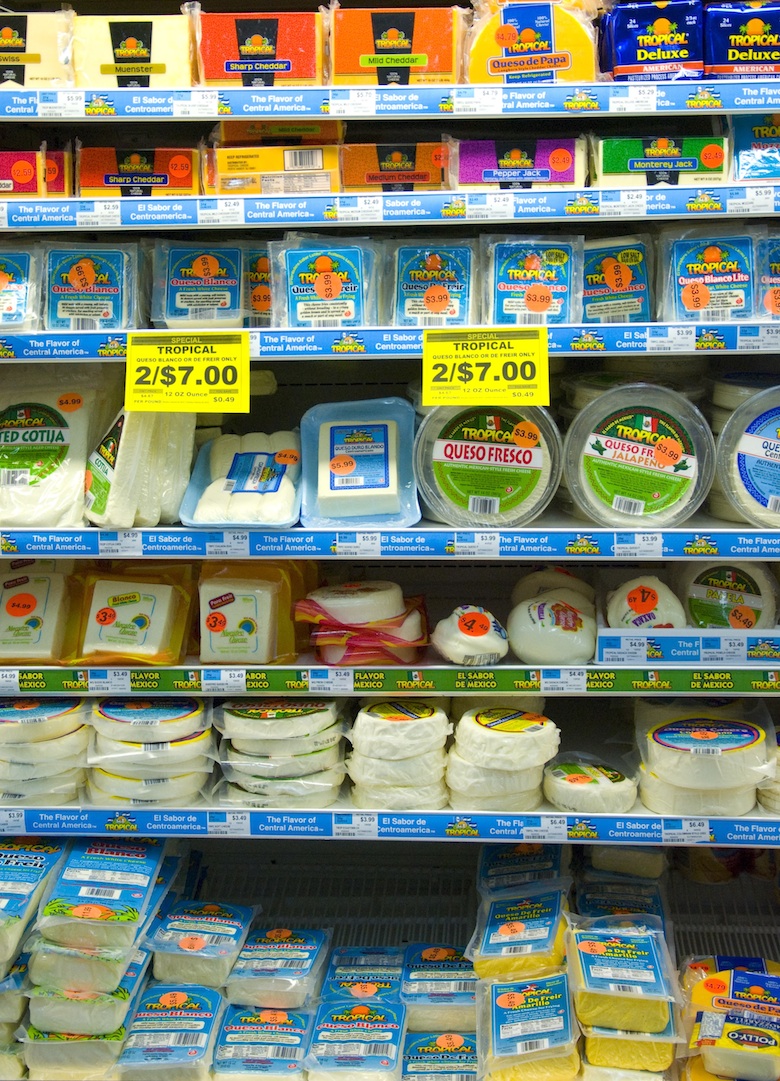 Whether you’re ready to try your hand at chiles rellenos or just want a creamy-salty punch for your homey frijoles, it’s time you hopped the A train to Washington Heights or made a beeline to Spanish Harlem.
Whether you’re ready to try your hand at chiles rellenos or just want a creamy-salty punch for your homey frijoles, it’s time you hopped the A train to Washington Heights or made a beeline to Spanish Harlem.
But once there, you needn’t seek out some obscure specialty shop stocking quality queso. Just step inside a supermarket. Sure, the awnings look like any other Met or Key Food, but uptown the dairy cases are carefully curated for Latino clientele, offering a small world of muy autentico Latin American and Caribbean cheeses. It’s easy to swap in queso fresco for mild feta or Cotija for Pecorino, but why settle for substitutions? Here are a few standbys to get you cooking.
Cotija
Taking its name from the town in the Michoacán state of Mexico where it originated, this salty, white, hard cheese is typically sold pre-grated or in triangular wedges. One of the few widely available aged Mexican cheeses, its low-moisture and high-salt content make it a keeper, literally. It’s great crumbled over tacos and tostadas, so skip the street-fair lines and slather your own grilled corn with mayo, then sprinkle with this.
Queso Fresco
Ever wondered how people can bear so many dishes laced with fiery chiles? It’s partly due to the judicious use of queso fresco. To tame the heat, throw it over chilaquiles swimming in salsa or huaraches piled high with seasoned pork.
Queso Panela
This moist, spongy cheese is made with milk curds that are salted then drained in a basket that gives it a distinct weave imprint and earns it the nickname queso canasta (“basket cheese”). A mildly salty blank slate, it will squeak and snap when served straight, or easily absorb flavors like garlic or chile powder.
Queso Blanco
Similar to Indian paneer, this semi-soft cheese becomes creamy inside when heated but holds its shape. For a hearty Dominican breakfast, fry a few thick slices and serve alongside the starchy mashed plantains called mangú and spicy longaniza sausage.
Quesito Colombiano
Falling somewhere between grainy queso fresco and creamy queso blanco, this fresh, semi-soft, nonmelting cheese is great with arepas but even better for dessert with fresh fruit or sweet preserves like dulce de mora or jalea de guayaba. For a fantastic salty-sweet combination, toss a few cubes into spicy hot chocolate like marshmallows to make a traditional Andean chocolate con queso.
Oaxaca
While most Hispanic cheeses hold firm, queso Oaxaca has no control at all. A low-moisture string cheese named for the state in south Mexico, it’s made from cooked curds that are stretched, then shaped into braids or balls. Perfect for stuffing quesadillas or topping enchiladas, it melts into buttery pools with the first kiss of heat and adds a creamy richness to pupusas, arepas and pan de queso.
Photo credit: Gloria Dawson



